Learn how to make sauerkraut easily at home, in four different flavors! Including a basic homemade sauerkraut recipe, plus a quick stove top version.
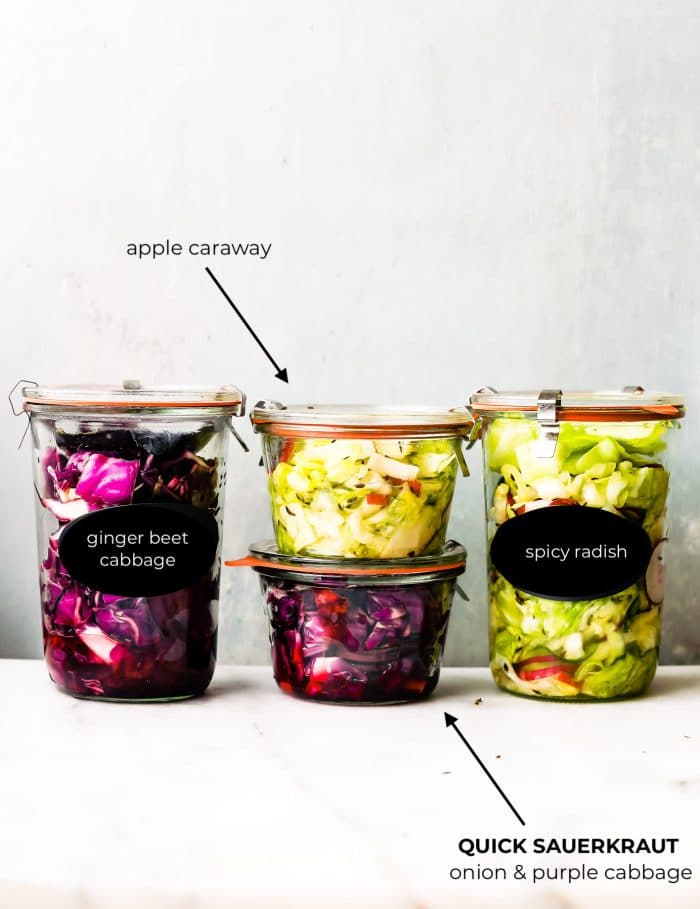
One week until Memorial Day and here I am sharing good for your gut food. Ooops! Actually, hear me out. This fermented veggie is a MUST for BBQ’s and summer holidays (think salads, grilled meat topping, side dishes, etc.) And just might help ease digestion when you’re consuming foods that aren’t so healthy, healthyish. You guys, fermented foods can do wonders with IBS, digestion, leaky gut, etc. I speak from 11+ years experience healing from digestive disorders. Yikes.
Also, I wanted to share my tips for making sauerkraut so that you didn’t feel so intimidated by the whole fermented veg thing. Education is key, don’t you think?
Speaking of fermented vegetables…..
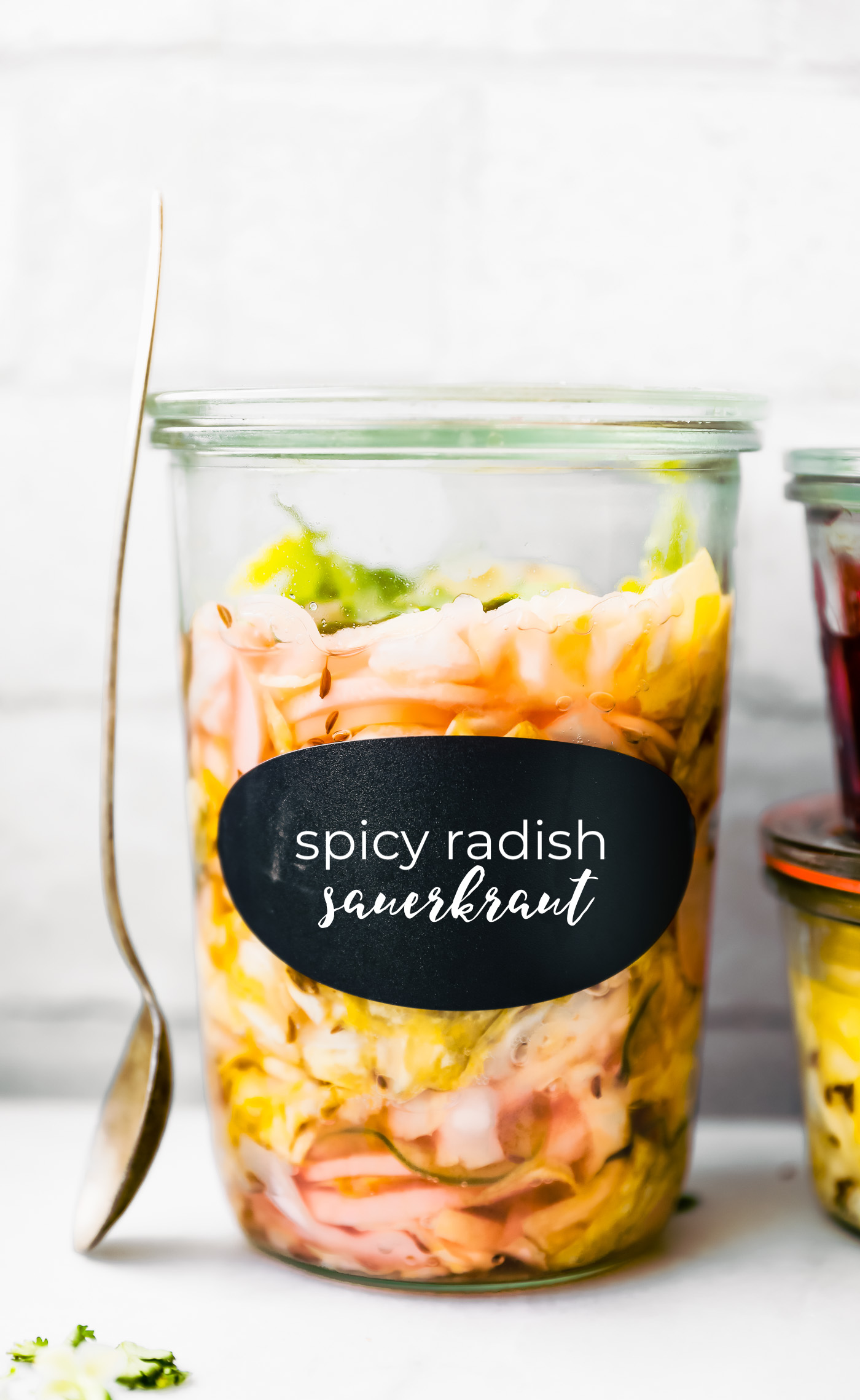
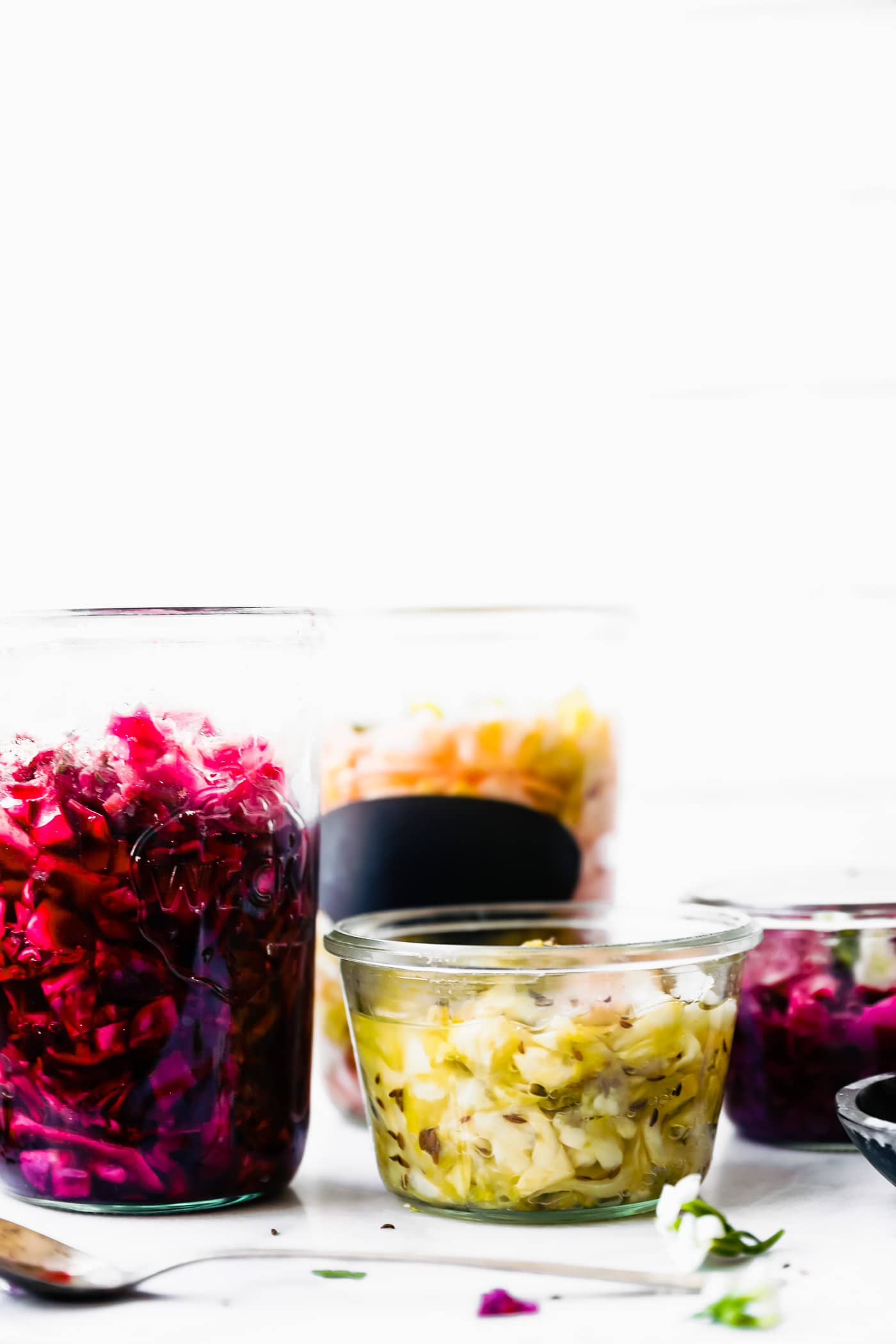
Fermented vegetables – good for gut health
This homemade sauerkraut recipe is made with cabbage; just one of my favorite fermented vegetables. Remember my easy kimchi recipe? That’s another favorite! The reason I want you to learn how to make sauerkraut is because fermented foods don’t just taste amazing, but they’re also great for your digestive system.
I talk about gut health a lot (as mentioned above). In fact, so often that you probably know how passionate I am about it. Ya’ll, traditional foods made with simple ingredients can turn your health around for the better.
Fermented foods are packed with probiotics. In case you haven’t heard, probiotics are a good bacteria that forms during the process of fermentation. We eat the good bacteria and as a result, they help to keep our gut happy and healthy.
So what is fermentation? Fermentation takes place when harmless bacteria consume the natural sugars in foods (like vegetables, fruit and milk), converting them to organic acids and carbon dioxide.
This process gives the food a slightly sour, tangy taste but also prevents harmful bacteria from growing. This is why fermentation is the ideal way to prevent food from spoiling. Plus it gives food a different but AWESOME flavor and texture.
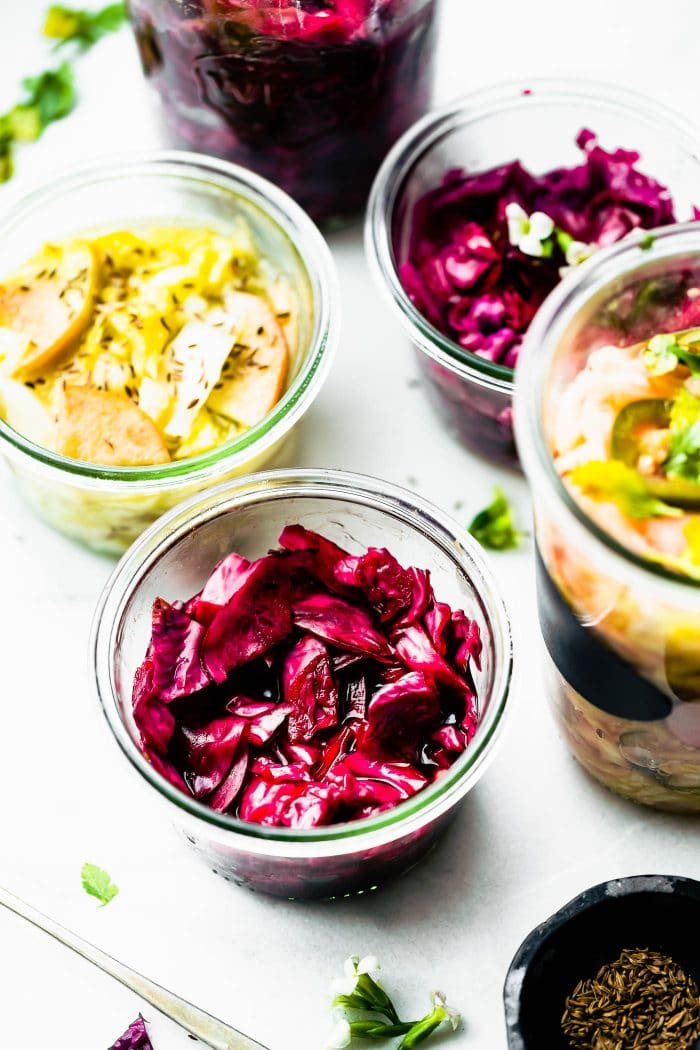
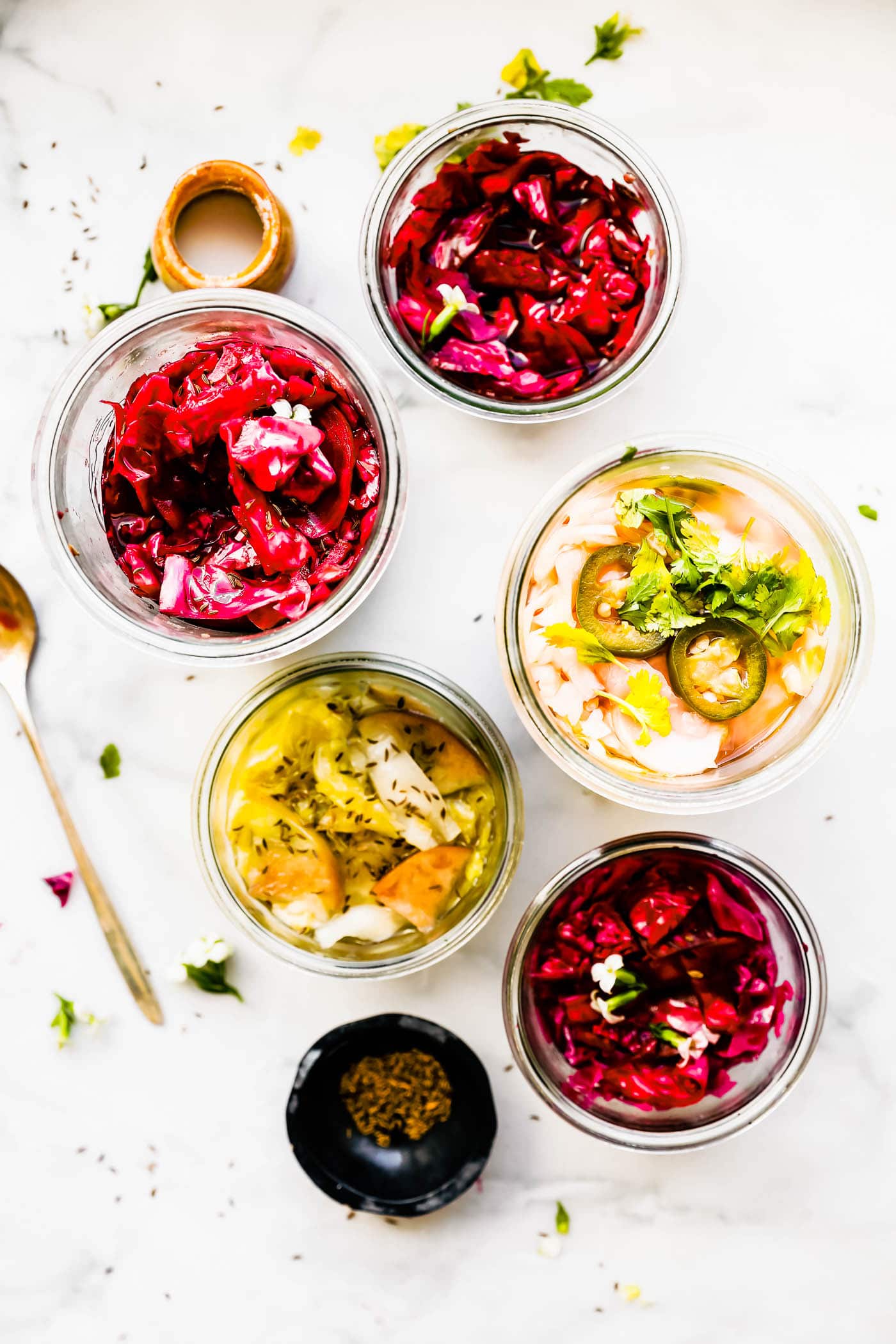
So, let’s learn how to make sauerkraut, in 4 different flavors. Why four flavors? Well, because you can never have too much of a good thing! And trust me, this homemade sauerkraut recipe is definitely a good thing!
Here are the varieties I have to share. Good luck trying to decide which one to make first!
- Red cabbage, beet, and ginger – delicious mixed with egg salad and potatoes.
- Apple caraway – my favorite on a turkey burger or veggie burger
- Spicy radish – killer topping for tacos!
- Onion and red cabbage – This is a quick stove top version. I could eat it by the jar full! Also great on grilled meats or fish.
Ways to Use Sauerkraut
There are a lot of tasty ways to use sauerkraut in recipes, but it’s also tasty on its own. It may be a simple side dish, but it’s packed with flavor!
- Give it a bit of SPICE with jalapeno and radish then top on a burger or taco.
- Apple sauerkraut is great on pork
- The beet and ginger version would be heavenly on veggie burgers or as topping for an omelet.
Or, keep it simple and serve the classic as a side dish with potatoes at a family picnic or gathering! I’m part german, it’s only natural to have potatoes and kraut at a family gathering. The kiwi (aka my New Zealand husband), on the other hand, is still new to it, but loves it with eggs and jalapeno! To each their own… with sauerkraut that is.
How to make sauerkraut
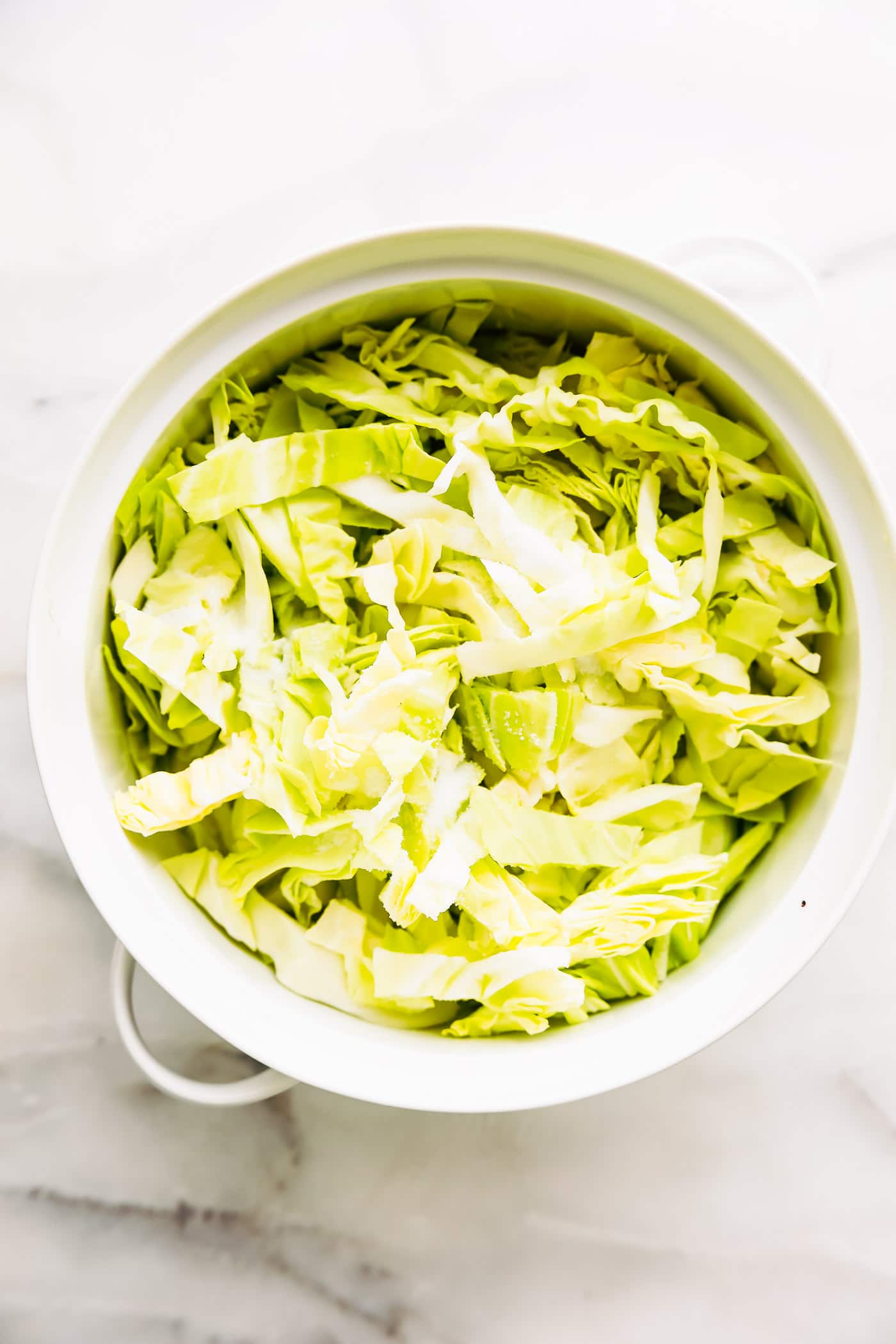
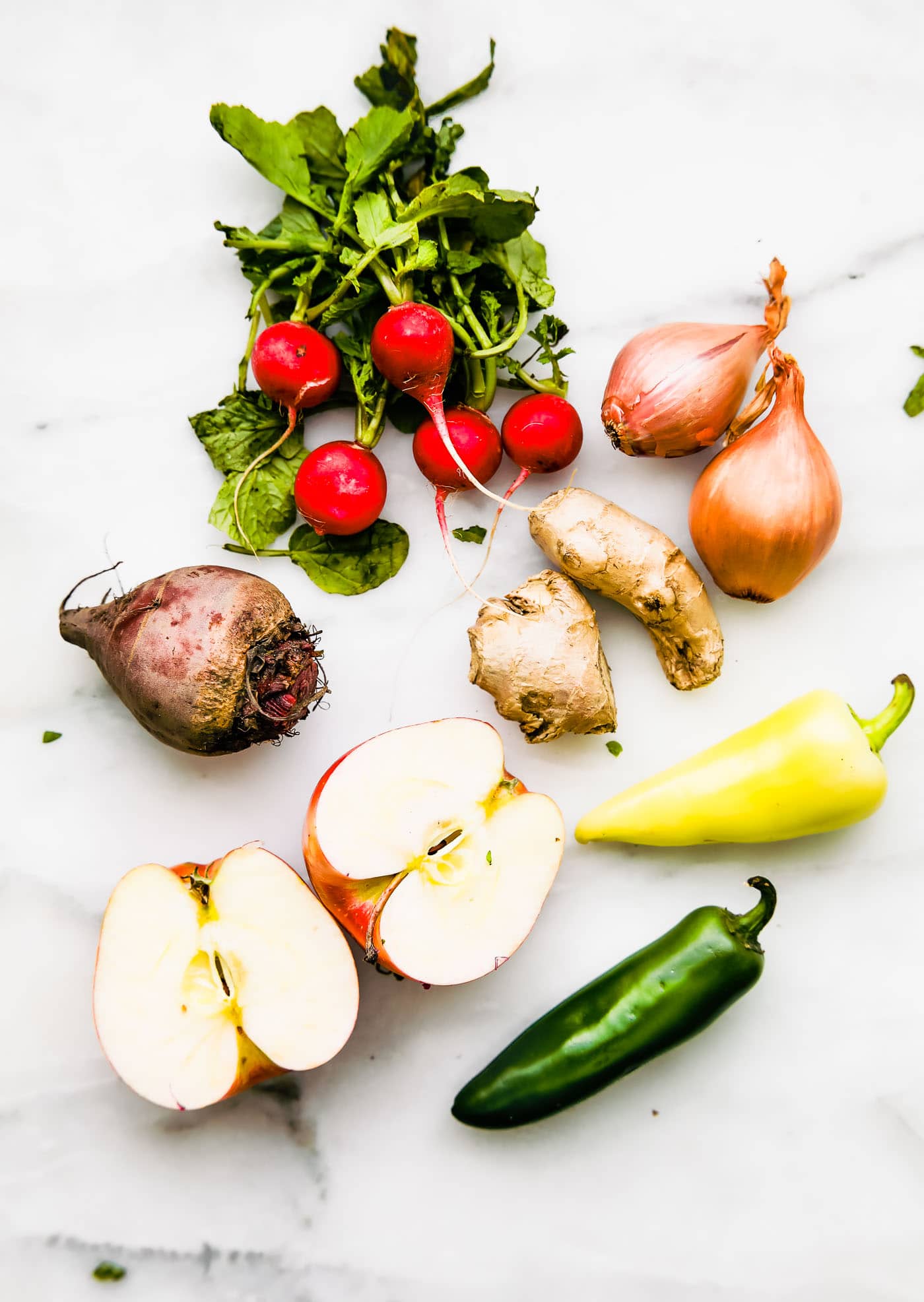
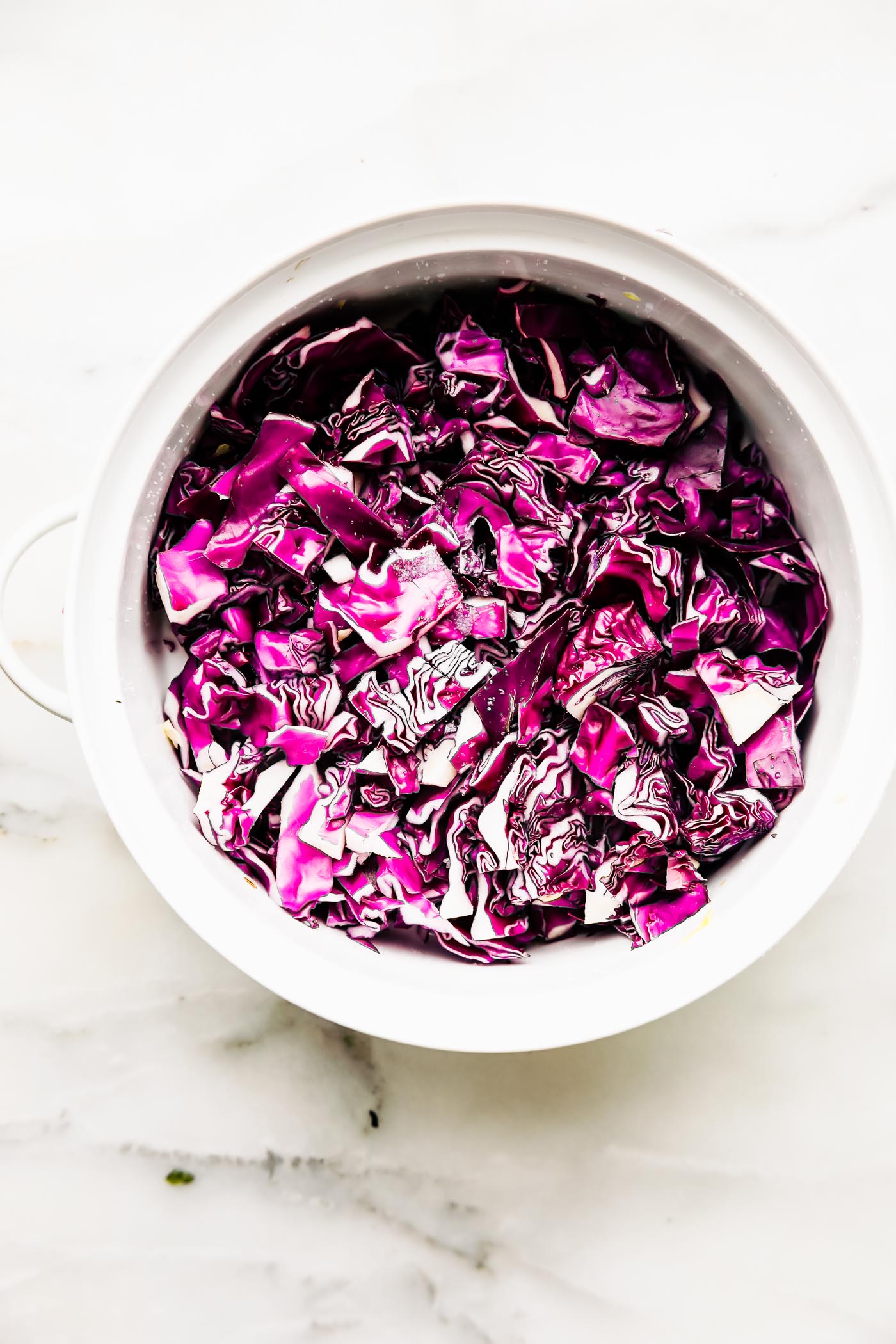
Let’s first go over what you need to make classic sauerkraut. Nothing fancy. Still tasty.
Classic ingredients
Ingredients
- 1 medium head of white cabbage
- kosher salt or pickling salt
- filtered water
- Glass jar, about 500-750 ml and a lid
- Large bucket, container or a mixing bowl
Once you get the hang of making classic sauerkraut, the flavoring add in are simple! Beets, apple, spices, pear, you name it! It’s all good. I’ll share my 4 favorite in the recipe tab below.
Now, the question remains.
Is there a quick way to make sauerkraut?
Yes! All you do is let the cabbage simmer with apple cider vinegar, spices, and oil in a saucepan! Okay so it’s not really fermented cabbage sauerkraut but the taste is similar. So if you’re not up for waiting a week for this gut health condiment, then by all means, try my quick version. It’s equally tasty and a great side dish or meat topper.
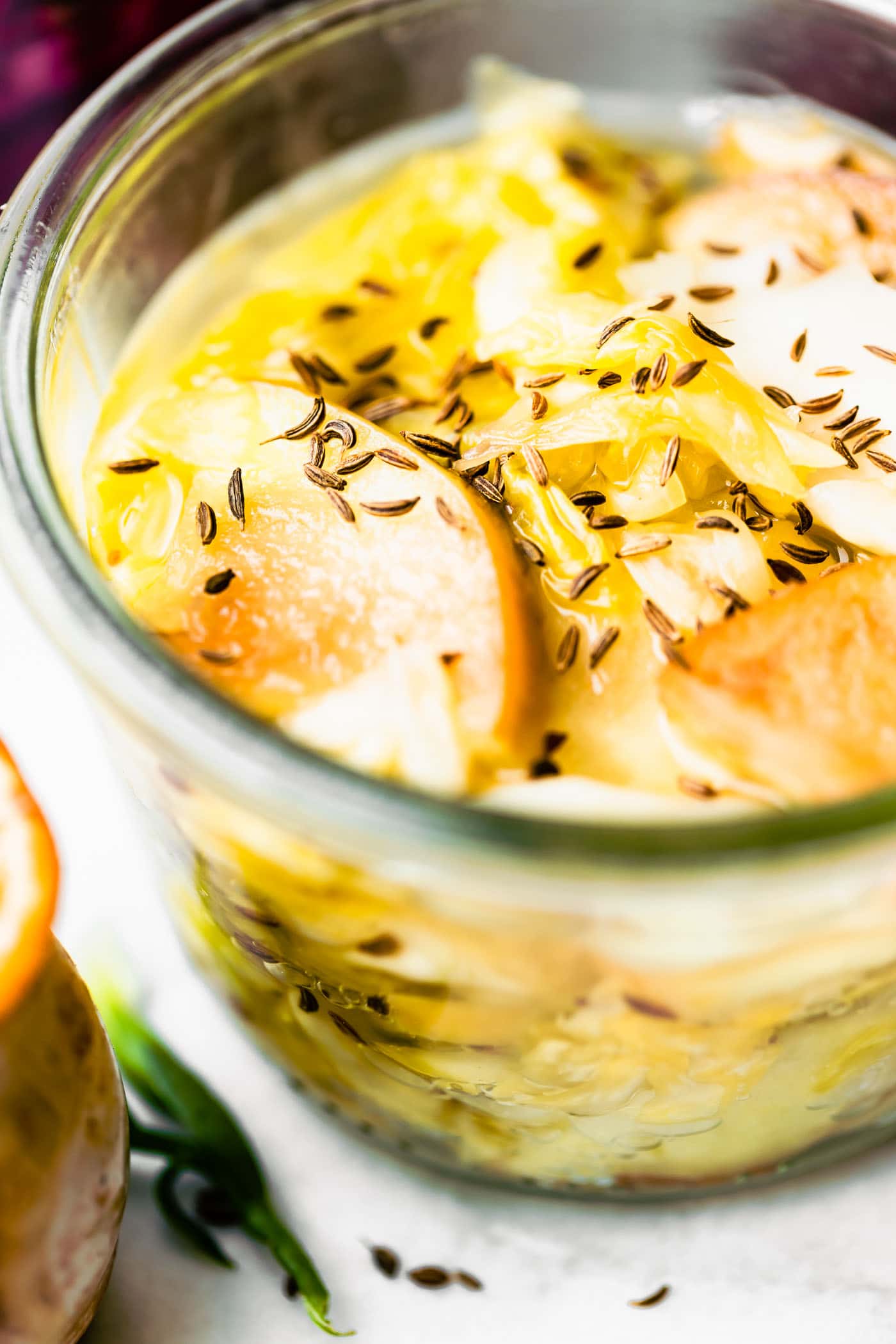
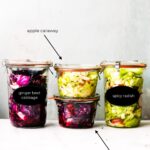
How to Make Sauerkraut (4 Flavors!)
- Total Time: 0 hours
- Yield: 6 1x
Description
Learn how to make sauerkraut easily at home, in four different flavors! Including a basic homemade sauerkraut recipe, plus a quick stove top version.
Ingredients
Classic Sauerkraut Ingredients
- 1 medium head green cabbage
- ½ medium head or 1 small head red cabbage
- 1 Tablespoon kosher salt or pickling salt + extra if needed
- ¼ cup or more filtered water
- Glass jars (10 ounces to 32 ounces)
4 flavor variations and techniques –
- Mix and match the following fruits or vegetables
- 1 cup apple, radish, or beets (peeled, thinly sliced or grated)
- 1 Tablespoon caraway seed
- 1 Tablespoon freshly grated ginger
- sliced jalapeño
Quick Stovetop Version
- 1 Tablespoon light olive oil
- ½ to ⅔ small red onion, sliced
- ½ head of small red cabbage, shredded
- ⅓ to ½ cup apple cider vinegar
- ¼ cup filtered water
- 2 teaspoons caraway seed
- salt and pepper, to taste
Instructions
Classic Sauerkraut Instructions
- Cut the cabbage into quarters, remove the core and shred or finely chop cabbage with a knife or use a food processor.
- Add shredded cabbage to a large bowl and sprinkle with kosher salt, gently stir and set aside for 30 minutes or up to 2 hours. The cabbage will “sweat” and create a brine. If adding in a fruit or vegetable (chopped apple, beets, jalapeño, or ginger), do so here with the cabbage.
- While the cabbage is creating the brine, prepare the jars. A variety of canning jars (10 ounce to 32 ounce) can be used, make sure they are clean and dry.
- Check the cabbage to see how much brine has been produced. Add the water to the cabbage and start squeezing the cabbage/vegetables with your hands to release more juices.
- If the cabbage does not release enough liquid, additional brine needs to the added. There needs to be enough liquid to cover the cabbage in each jar. TIP —> to make a brine simple combine water and pickling salt in a ratio of 1 cup water to 1 teaspoon pickling salt.
- Pack the cabbage and any other additional flavorings/ingredients (see flavor combos below) tightly into a clean jar. With a spoon or clean hand, push down the cabbage so it’s very compacted at the bottom of the jar. The brine should fill to the top. If there is not enough brine to cover the cabbage, add more of your own (mentioned above). Leave about 1 inch of room at the top of the jar. TIP —> Use a clean marble or stone placed on top of the cabbage once it’s pushed down in the jar to help it stay compact while fermenting. Cover tightly with the lid and leave the jars to ferment on the counter or in a warmer spot in the kitchen.
- For the first few days, “burb” the jars by opening the lid(s) each day and letting out any pressure. Make sure to press the cabbage down to keep it submerged in the brine. Add more brine if needed.
- If any discolored cabbage appears at the top, remove and discard it. If the water level gets too low, add more brine to cover the cabbage. The cabbage mixture must be submerged completely in brine to ferment safely. The sauerkraut is ready when it has a nice crunch, slightly soft texture and tangy flavor.
- Taste sauerkraut every few days. After 7 to 10 days the sauerkraut should be fermented enough to start consuming. Ferment longer for a more tangy and soft kraut. Keep the jar(s) in the fridge for up to 2 months.
Flavor combos – Prepare as classic sauerkraut, except add the fruit and/or vegetables with the cabbage mix. Choose one of the following combos below.
- 1 cup sliced radish and 1 sliced jalapeño
- 1 peeled and sliced beet with 1 Tablespoon grated ginger (pairs well with the red cabbage)
- 1 sliced apple and 1 Tablespoon caraway seeds (pairs well with the green cabbage)
Stovetop Directions (skip the fermenting)
- In a medium saucepan, heat the olive oil over medium heat. Add sliced red onion and sauté until fragrant or about 2 minutes. Add shredded red cabbage, vinegar, water, caraway seeds, salt and pepper.
- Cover and cook on low to medium stirring occasionally, until onion and cabbage are tender or about 30 to 35 minutes. Remove and let cool. Place in a canning jar and seal tightly. Store in the refrigerator for 1 to 2 weeks.
Notes
Cooking Tip – If mold forms on the top portion of cabbage while fermenting, discard that portion. If the mold has touched the jars, discard sauerkraut.
Nutrition below based on classic sauerkraut
- Prep Time: 7-10 days
- Category: condiment
- Method: fermentation
- Cuisine: german
Nutrition
- Serving Size:
- Calories: 43
- Sugar: 5.4 g
- Sodium: 1200.5 mg
- Fat: 0.2 g
- Saturated Fat: 0 g
- Carbohydrates: 10.3 g
- Fiber: 2.9 g
- Protein: 2 g
- Cholesterol: 0 mg
Sauerkraut lovers, tell me your favorite recipe to use it in! Or do you have your homemade sauerkraut version? I’m all ears.
Cheers to fermented goodness!
LC
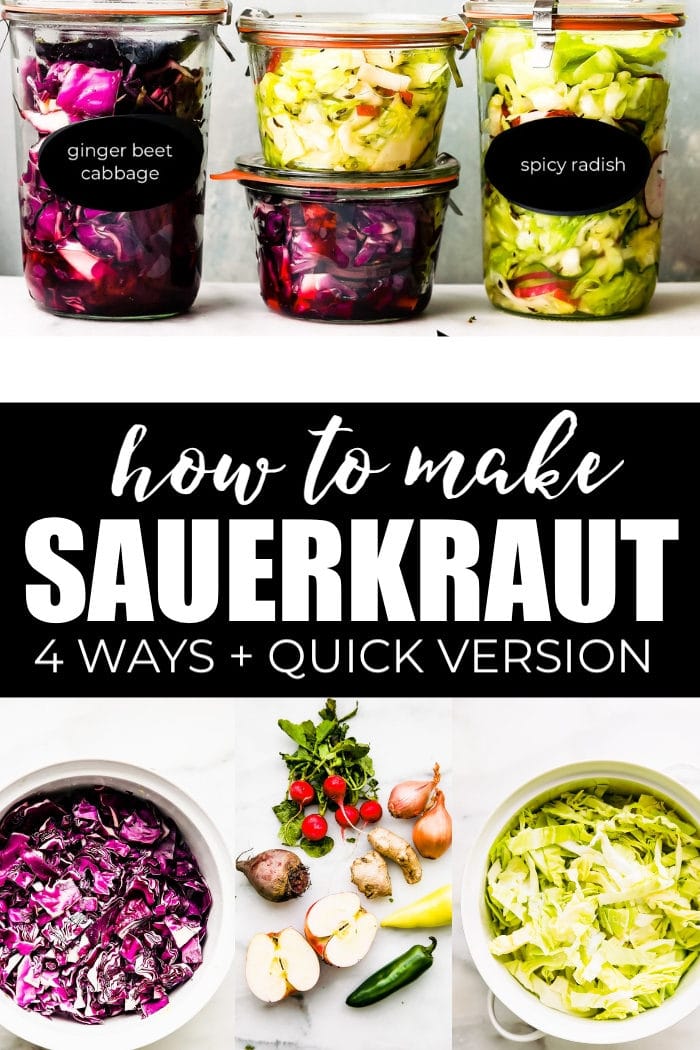


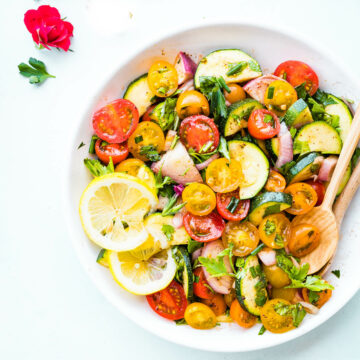





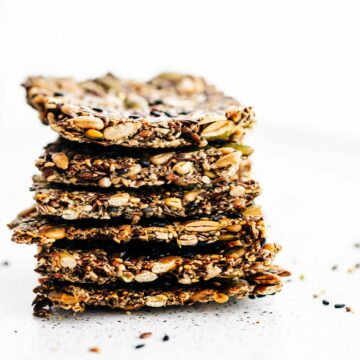



hi there,
Should I be doing anything with the beats or apples before hand? or just placing them in the jars with the cabbage
Thanks!
Hi! The beets and apples are peeled and thinly sliced or grated then added to the cabbage in the jars. Does that make sense? Happy to help!
If I made the quick version, will it still have all the wonderful probiotics as the original recipe version?
Absolutely! The longer it ferments the better but you’ll still get a good amount of probiotics.
Sauerkraut tends to be super expensive at most health foods stores! Can’t believe it’s so easy to recreate at home. Thank you for all of these beautiful and yummy-looking ideas! The ginger beet sauerkraut is definitely calling my name. The color is stunning! But each flavor looks splendid. Happy cooking (and feasting)!
Thank you so much!! My pleasure to share:) oooo yes, indulge in that out, it’s fantastic;)
We made the original version, and served it with porkchops. Time consuming, but so worth the wait!
That sounds incredible! I’m glad it turned out for you:)
Hey Lindsay,
The Article on How to Make Sauerkraut is nice. i was searching on internet about this ,Thanks for Sharing the information on it.
I’m glad you enjoyed it-thank you!
I really loved all the flavors! Thank you so much!
love all of these, especially the quick version since I don’t usually think ahead when I decide on a full German with schnitzel and spaetzel (pressed through a collander and dropped straight into the boiling water, perfect shape!), thank you
Right?? I got you? (and holy delicious, you whip up some of that, I’ll bring the sauerkraut, and we’ll have ourselves a German feast?)
I started out with your classic sauerkraut and it was so easy and tasty! Now I’ll be working my way through a couple of your variations!
Awesome! Glad to hear it, Liz. Lmk how it goes!
Best tutorial I’ve ever seen for this!
Woohoo!! That means a lot Cathy, thank you❤️
In partial to your onion variation (#4) for the sauerkraut. Yay for fermented vegetables!
Aren’t they just the best?!??